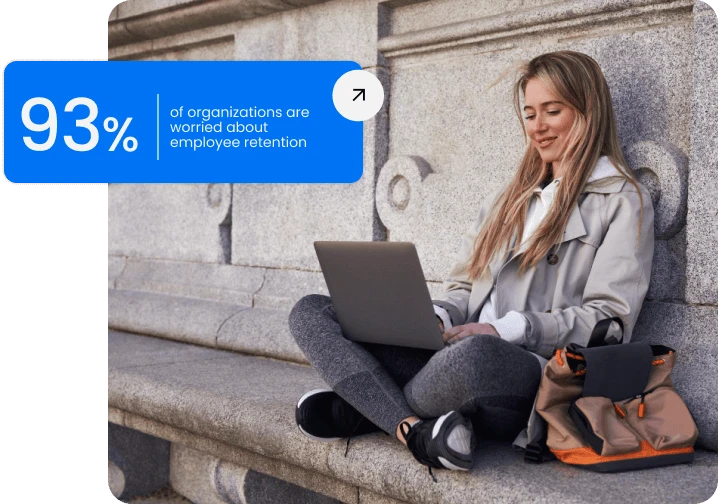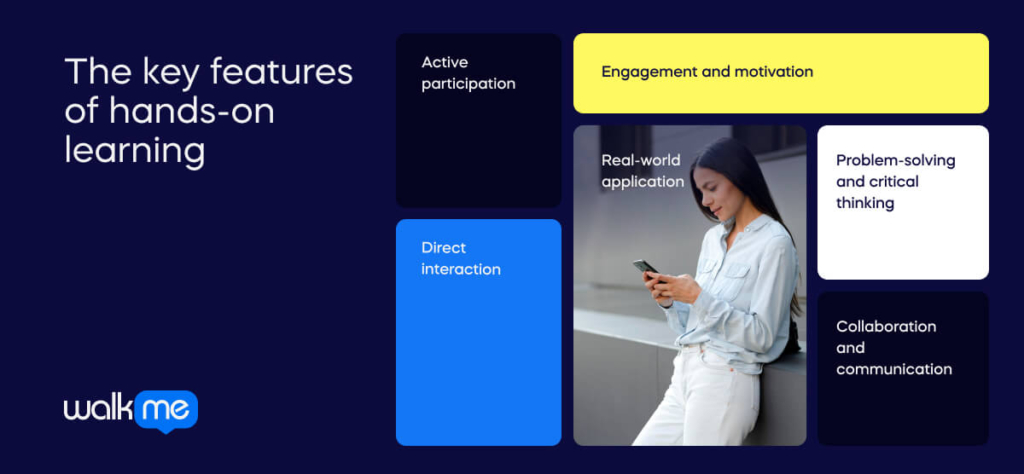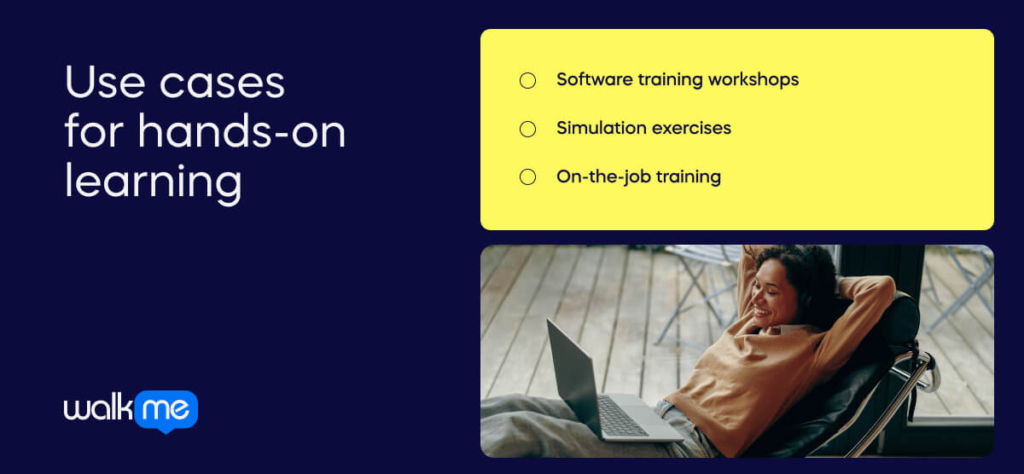Hands-on learning

Hands-on learning, or experiential learning, is where people actively engage with a tool or product. They can get physically involved instead of being given instructions or relying on theory. Because people directly interact with the tool, they will learn how to use it through firsthand experience. Ways of delivering hands-on learning include interactive eLearning, simulations, and on-the-job training.
- In workshops, people are given instructions and then try them out in real-time
- Simulations are a safe place for people to practice using a tool in pretend scenarios
- On-the-job training lets people apply their learning to everyday tasks right away
Hands-on learning can result in a deeper level of understanding. People are more likely to remember what they have learned. As a result, people can adapt to constantly changing digital environments more quickly. Why should organizations focus on making the shift to experiential learning?
- 93% of organizations are worried about employee retention. The top way to improve it is by providing learning opportunities.
- 8 in 10 people say that learning gives their work an added purpose. In other words, companies that invest in learning will gain employees who are invested in the business’s success.
What are the key features of hands-on learning?

Hands-on learning has many distinctive features that make it stand out. This particularly applies to the digital world, where people need to keep up with evolving technology. It is a dynamic and immersive approach to education. People can actively engage, develop practical skills, and learn about a concept more meaningfully. Let’s take a look at what experiential learning involves in more depth:
Active participation
Learners do activities, exercises, or experiments to learn instead of just listening.
Direct interaction
People directly interact with what they’re learning about. This lets them get feedback right away and make changes.
Real-world application
Hands-on learning often copies real-life situations so people can use what they’ve learned in real life.
Engagement and motivation
When people take part and experience learning directly, they become more interested and excited to learn.
Problem-solving and critical thinking
Hands-on learning helps people solve problems, make choices, and think carefully, which builds their thinking skills.
Collaboration and communication
Hands-on tasks often involve working with others, which can improve teamwork, communication, and interpersonal relationships.
Hands-on learning vs lecturing
Hands-on learning is very different from traditional lecturing or training. In a nutshell:
- Hands-on learning is about actively doing things and practicing with new technology or systems
- Lecturing is more about listening and getting information from someone explaining things
Let’s take a closer look:
| Hands-on learning | Lecturing | |
| Definition | Using new technologies or systems through practical activities, simulations, or real-world tasks. Employees learn by doing things instead of just listening. | When someone explains or teaches about new technologies or systems to employees. They usually talk or show slides to share information. |
| Focus | Learning by doing and practicing with new technologies or systems. It helps employees get better at using them in their jobs. | Giving information about new technologies or systems. Employees listen and learn, but they might not get to practice using them right away. |
| Techniques | Workshops, simulations, or on-the-job training. Employees get to try out new technologies or systems and learn by doing. | Presentations, videos, or written materials. Employees listen or read to understand how new technologies or systems work. |
| Goals | To help employees improve at using new technologies or systems in their jobs. They learn by practicing and doing things themselves. | To give employees information about new technologies or systems so they can understand how they work. This helps them familiarize themselves with the basics before they start using them. |
| Examples of use | Used in workplace training programs to teach employees how to use new software or systems. For example, employees might attend workshops to practice using a new customer management system. | Happens during meetings or training sessions where an expert explains how to use new technologies or systems. For instance, an IT specialist might give a presentation on the features of a new software tool. |
Use cases for hands-on learning

Hands-on learning is helpful in many different business situations. In software training workshops, employees practice using new software, learning how it works for specific tasks. In simulation exercises, customer service teams practice handling different situations, improving their communication with customers, and solving problems. During on-the-job training, new hires learn by doing tasks with experienced workers, becoming more confident in their jobs. Let’s look closer at each of these examples:
Software training workshops
- Employees take part in workshops which are set up to teach them how to use new software
- The workshops involve hands-on practice. Employees can use the interface during the session
- They can try out new features and functions in real-time with support available if they need it
- Employees become familiar with the software and gain practical experience in using it for specific tasks
Simulation exercises
- Customer service teams take part in simulations so they can learn how to handle various inquiries and situations
- Team members role-play as both customers and service agents
- They practice communication techniques and problem-solving strategies
- Employees learn how to effectively listen, provide the right assistance, and use the correct software for managing the interaction
- They feel more confident and prepared to handle similar situations in real life
On-the-job training
- New hires at a manufacturing company learn the ins and outs of operating equipment with on-the-job training
- They also learn about the correct safety protocols
- The new employees work closely with experienced workers who guide them through the tasks and procedures they will be performing
- The newcomers develop the skills needed through hands-on experience and guidance
- They also feel more confident in performing their job responsibilities
What are the advantages of hands-on learning?
Hands-on learning has many benefits. By participating in practical activities, people can understand more deeply and learn valuable skills. As a result, they become more confident and perform better in real-life scenarios. Let’s take a further look at how hands-on learning can help:
Active engagement
Hands-on learning means you’re doing things, not just listening. It helps you understand and remember better.
Practical experience
You get to try things out yourself, like using tools or software. It’s like practice for the real world.
Skill development
Hands-on learning helps you learn how to solve problems and use your hands. These are important skills for many jobs.
Increased motivation
Doing things yourself can make learning more interesting and keep you interested.
Personalized learning
You can learn at your own pace and focus on what you need to know.
Memory boost
Doing things yourself helps you remember them because you’re actively involved.
Builds confidence
When you practice and get better at something, it makes you feel more sure of yourself.
Encourages creativity
Trying new things and solving problems can make you more imaginative and think of new ideas.
Promotes collaboration
Doing hands-on activities often means working with others, which helps you learn how to cooperate.
What are the challenges of hands-on learning?
Let’s explore the issues that can be linked with hands-on learning. While there are many benefits, the challenges should also be remembered. These difficulties can make hands-on learning strategies less effective and more complex to roll out. Here’s a closer look at the challenges:
Resource limitations
Sometimes, there isn’t the right equipment available for hands-on learning.
Time constraints
Hands-on activities need more time to set up and do, which can be tricky to fit into schedules.
Safety concerns
Doing things hands-on might have risks, so it’s important to be careful and follow safety rules.
Individual differences
Not everyone learns the same way, so it can be hard to make hands-on activities work for everyone.
Assessment difficulty
Figuring out if hands-on learning really works can be tough because it’s not always easy to measure how much someone has learned.
How can DAPs help with hands-on learning?
Digital adoption platforms (DAPs) might not seem like the right solution for hands-on learning, which usually involves physical activities. However, DAPs can be really helpful in these situations for many reasons. For example, employees learning a new software can watch short videos or read helpful tips while working. This lets them learn a feature or solve a problem without interrupting their own work to ask for help. Furthermore, DAPs can track progress as people learn a new product or service. This data can then be used to see where the main issues are and make hands-on learning even better. Here’s a more detailed look at how DAPs can help with hands-on learning.
In-context guidance
In-context guidance, or in-app guidance, means providing help right where a user is working. A DAP may provide pop-up guides, short videos, or interactive flows. These offer detailed information or instructions at the exact moment the user needs them.
| How can WalkMe help? Smart Walk-Thrus: WalkMe creates guided walkthroughs that help learners understand what they need to do. These walkthroughs offer visual prompts and can be applied directly to the software being used for the hands-on activity. Learners who understand where to click or interact at each step become less confused and frustrated. Hotspots: With WalkMe, people can create hotspots in particular sections of an interface. When a user clicks on a hotspot, a pop-up explanation, image, or short video will be triggered. It will provide the user with information about the steps they are taking. As a result, they understand why they are doing it—not just how to complete the step. |
Interactive learning
Interactive learning occurs when learners interact with quizzes, polls, drag-and-drop exercises, and similar activities. They understand a process and remember it more easily. With a DAP, these types of learning can be overlaid onto a platform.
| How can WalkMe help? Interactive elements: WalkMe offers features like in-guide quizzes or polls to make learning more interactive. For example, the DAP can pause and ask a learner a question after a step. This reinforces important information and checks for understanding before the learner continues. |
Narrated walkthroughs
Not everyone learns the same way. DAPs cater to all kinds of learners. For those who are audio-based learners, narrated walkthroughs can work well. DAPs can provide walkthroughs or instructions that come with voice narration.
| How can WalkMe help? Screen recording with voiceovers: WalkMe allows for recording walkthroughs with voiceovers. This can be particularly helpful for complex hands-on tasks. Detailed narration is given alongside visuals to help with understanding. |
Success stories with hands-on learning
WalkMe has helped many companies to introduce hands-on learning environments and reduce the need for traditional training. Here’s an example:
Robert Half x WalkMe
When Robert Half chose to migrate from Salesforce Classic to Lightning, they wanted to ensure their staff could learn on the job with little downtime. They decided to work with WalkMe so they could roll out on-the-spot coaching, which would empower each employee to be more successful. Employees can activate a Smart Walk-Thru to learn about a process within the platform and get answers to their problems without contacting the support team. With this new, hands-on learning approach, Robert Half has provided real-time coaching to over 10,000 people across 18 countries.